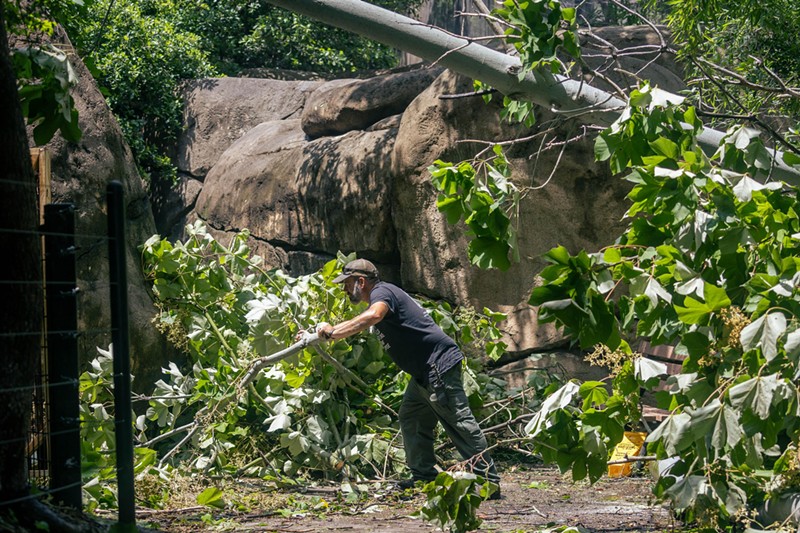“We sustained some pretty significant tree damage throughout the day on Tuesday,” Kari Streiber, the Dallas Zoo’s vice president of marketing, tells the Observer. “We were closed [on Tuesday] to allow the team to assess and clear debris and make sure everything was okay.”
Streiber says the zoo was fortunate in that the structural damage was limited, with the heaviest blow being dealt to a cloth covering a shaded area for guests.
“Every tree, tree branch, tree limb — everything that came down fell exactly where it needed to be to avoid damaging a building or a habitat,” Streiber says. “So we were focused yesterday on cleanup versus on any sort of significant repair or animal injury or anything. It was a very fortunate day.”
All of the animals at the zoo were confirmed to be safe and healthy after the storm, as most of them had been in their indoor habitats.
“A lot of the animals go indoors [at night],” Streiber says. “So they were still secure yesterday morning. [...] Almost everybody who was out went back indoors.”
According to Streiber, zoo officials pay special attention to weather forecasts to be prepared for events like this. At the time of the storm, there were already teams on site ready to weather it.
“The first step for us is to assess habitats and account for animals and confirm their safety,” she says. “Once that was done yesterday morning, the teams who were here started to focus on what the damage was and assessing power outages and building issues.”
A stable source of power is critical in providing animals the care they need.
“We do have generators and backup power that we use if the power goes out for an extended amount of time, whether it was the storm or whether it was the big ice storm,” Streiber says. “We make sure that the hospital, the nutrition center and some of the areas with temperature-sensitive animals have those generators.”
Re-leaf Efforts
The issue of falling trees and debris becomes twice as complicated when your space is dedicated to plant life. Sabina Carr, the CEO of the Dallas Arboretum, is currently reckoning with damage done by and to their trees.“We lost quite a few mature trees,” Carr says. “We had a lot of trees split in half and fall all over various areas of the garden. Thankfully, it happened in the middle of the night when no one was there.”
One mature tree destroyed by the storm was an almost 200-year-old white oak behind the historic DeGolyer Home, which would’ve been present when the DeGolyer family first lived there in 1839. When the tree split in two, one half landed on the recently renovated roof of the house.
The Arboretum reopened on Wednesday, but with quite a few areas closed off. The Children’s Garden, the Women’s Garden and the Magnolia Glade are still being cleared of debris.
“We haven't uncovered all the damage because these giant limbs or trees are still on top of what's planted,” Carr says. “We need arborists to get on site and start taking trees away.”
Mature trees are irreplaceable. Many of the flowers, luckily, are annuals that will be replanted in their next season.
According to Carr, it’s been easy to take preventive measures in other severe weather situations like the winter storm. The freeze is easier to predict in advance and preparation usually boils down to putting a frost cloth over the plants. With violent thunderstorms like the one on Tuesday, the best staff can do is cross their fingers.
“You just make sure no one's there,” she says. “And then you just have to deal with the aftermath, unfortunately.”
For both the zoo and the arboretum, trees and physical structures were not all that took a blow. Time and money spent clearing debris and making repairs is time and money they won’t receive from the public.
“You lose the revenue on the day you’re closed,” Carr says. “We could have had 2,000 people on the day after Memorial Day. The weather has been beautiful.”
Luckily, there are ways for fans of these institutions to help out in this process. The zoo, for instance, would like to replace their tree debris with some of yours,
“We have a program called the Browse Program,” Streiber says. “Browse is essentially small twigs and green leaves that kind of shoot from trees and shrubs. A lot of our large animals like elephants and giraffes love to eat that.”
There’s a page on the zoo’s website that breaks down exactly what kind of branches and leaves they’re looking for.
As for the Arboretum, a simple donation or time spent volunteering would be appreciated.
“A donation to help us restore the trees would be wonderful,” says Carr. “Volunteering for the arboretum is another great way to get involved. There are lots of different volunteer opportunities.”
The Dallas Zoo and the Dallas Arboretum have both reopened, with some areas closed off for repair. More information on their hours, their work and ways to get involved can be found on their respective websites.












